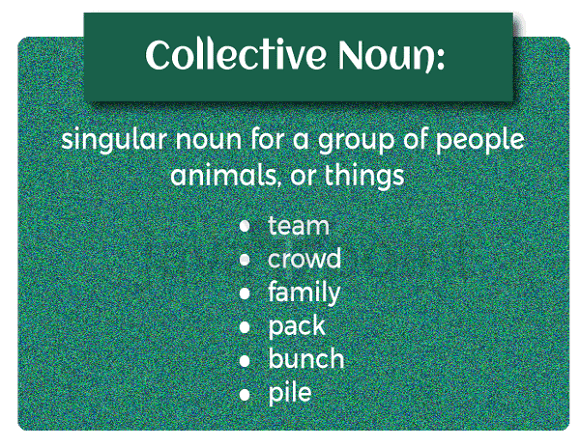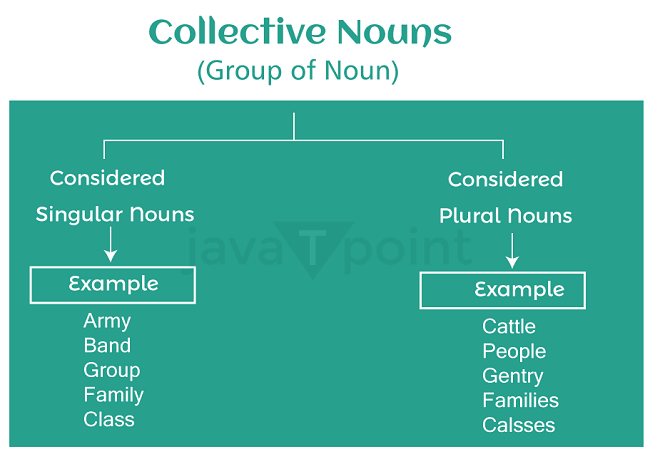Collective Noun Definition and ExamplesCollective nouns are titles for a collection or a group of persons or things. Collective nouns include words like team, herd, and array. Here, we'll look more closely at what are collective nouns and look at some examples, putting them in place so you can grasp how they work. 
What Exactly Is a Collective Noun?We may not pay attention but collective nouns are most often use din everyday routine. Collective nouns words usually employed for a collection or a group that comprises of more than one person, animal, place, object, or idea. A team cannot exist without distinct members; however, we refer to a team as one cohesive unit. One thing to keep in mind when using collective nouns in sentences is to utilize the correct verb form. Definition of a Collective NounCollective noun has been defined by various dictionaries, let us have a look at few definitions;

Examples: Collective Nouns in a SentenceHere are few examples of collective nouns in a sentence;
How To Use Collective NounsWhen utilizing collective nouns, individuals who are new to writing sometimes struggle with sentence coherence. This is logical given that a collective noun can be singular or plural based on the context of a phrase. How can you tell if a collective noun is singular or plural? How do you know if it's plural? Which pronouns and verbs work best with the collective noun that you've selected? Here's a quick tip for determining how to utilize collective nouns in sentences: Consider a group of zebras happily grazing on the savanna. A lion leaps out of a cluster of tall grass. They flee as a single entity, racing across the grassland in the same path, as they try to make an exit. People frequently react in the same manner, participating in a particular activity in tandem with everybody else in their group. Persons who are members of a group, a choir, a squad, or any other collective noun comprise of a singular noun that is related with singular pronouns and singular verbs. As you try and understand the examples below, make a note that every individual who is a part of the collective noun is performing clearly the same act as other individuals who are part of the respective collective noun. The herd accompanies their leader to the drinking spot every morning for drinking water. Herd is a singular collective noun. The word that comes after is a singular verb, and the term that follows its is a singular pronoun. All the creatures in the herd show up at the drinking spot at the same time. Mr Richards class carries its test today. The single collective noun is class. The verb carries is singular, while the pronoun its is singular. All the pupils in Mr Richards class are undergoing the same test at same time. The committee accepts that individuals are exploiting their mobile phones, its decision is that mobile phones should not be used during work hours. → The singular collective noun is committee. The verb accepts is singular, as well as the pronoun its is singular. All the committee individuals are thinking in the same way. Consider three teens in your living room. Are they all carrying out the same thing at the same time? Most likely not! One is glued to the television. Another option is reading a novel while listening to music. The third is staring at the TV while working on his PC. There is a single group of teenagers, yet each one is doing something different. Individuals of collective nouns can behave in the same way that individuals do. When the participants in a collective noun act as individuals, the collective noun becomes plural and requires the use of plural pronouns and plural verbs. You'll note that each of the members of the collective noun are not working in tandem as you read the examples below. After seven hours of sitting in the stifling tribunal, the jury gets up, checks their watches, and walks to their motor vehicles for the drive home. → In this case, jury is a plural collective noun. Get up and checks, and walk are all plural verbs with a plural pronoun. The jury members are getting up and checking their watches before departing in separate vehicles to their different homes. Following an exam, the class begin writing their papers on William Shakespeare's poems. In this case, class is a plural collective noun. Begin is a plural verb and their is a plural pronoun. Despite being in the same class, the pupils are starting their respective papers on several poems penned by William Shakespeare. 
What If You Are Unable to Determine If a Collective Noun Should Be Singular Or Plural?To ensure that there is no agreement problem, you might create your statement with alternative words. For example, after a collective noun, you can include the phrase "members" or use an alternative term such as "players" rather than "team," "Elephants" instead of "herd," or "pupils" instead of "class." Reread what you've written to ensure that it seems natural, and allow yourself some practice time. You'll soon be able to employ plural verbs without stressing about making mistakes. 3 Ways to Recognize and Use Collective NounsTip #1: If the word needs to be used by more than one person, animal, or thing, it is most likely a collective noun. Remember that collective nouns are terms or phrases that describe a group of persons or objects as a single entity. Consider this: If I were watching at a swarm of bees soaring across the sky, would I see one thing or numerous things? When I think of a flock, I think of a bunch of birds flying together. As a result, flock is a collective noun. The word flock refers to a group of animals/ birds in this case. Tip #2: Singular collective nouns employ singular verbs, while plural collective nouns utilize plural verbs. Remember that collective nouns are regarded singular until made plural. Verbs utilized with collective nouns must utilize single verbs along with singular collective nouns as well as plural verbs solely if the collective noun has been turned plural. The class is obligated to follow the rules of the lecture hall. The classes are obligated to observe the rules of the lecture hall. Tip #3: Pronoun Agreement : Collective nouns that are singular used singular pronouns, while plural collective nouns utilize plural pronouns. Remember: Pronoun agreement, particularly subject-verb agreement, must be carefully examined to ensure that singular pronouns are utilized for singularly collective nouns while plural pronouns are utilized for plural collective nouns. The team on the airplane carrier is set up to use if it is meant to. The teams on airplane carriers are set up to use if they are meant to. Examples Of Collective NounThere are countless collective nouns in English Language. There are collective nouns for animals, individuals and even things. However we will look at some of the most common ones here.
What's The Difference Between Collective And Plural Nouns?Plural implies to something that is "more than one," hence plural nouns applies to more than one of the same noun. The easiest way to turn a noun plural is to attach an 's' to the conclusion of the word, but there are a numerous of other possibilities. Examples: Fan (singular) / Fans (plural) Pen (singular) / Pens (plural) Remote (Singular)/ Remotes (Plural) Table (Singular)/ Tables( Plural) Notebook (Singular)/ Notebooks (Plural) Collective nouns are singular terms that are used to replace plural nouns. Collective nouns may be either singular or plural, while plural nouns can never be singular. Let us understand an example for this: A team is learning about the various types of nouns. What exactly is a team? It is a team of people, locations, or things. In this scenario, we may deduce that the team is a group pf learners or students The term "students" refers to a group of students. The following sentence could be expressed without the use of a collective noun: Students are studying about various noun categories. Students (Team) are studying about various noun types. So collective nouns aren't plural if they contain more than one of the exact same thing? It's common to conceive of collective nouns as plural; yet, these terms are intended to express a single unit of more than one of the same object. Collective nouns can also be plural: Teams are studying about various noun kinds. In this statement, what does "teams" mean? It refers to multiple groups, which makes it a plural collective noun. Collective Proper NounWhen a proper noun symbolizes a group, it can also be a collective noun. Collective nouns are frequently used for music groups and enterprises.
Since Magenta 4 is a musical group with numerous members, it is a collective proper noun that is used in sentences as a singular noun.
Walmart is a major retail chain, so it is a collective proper noun in this sentence. When a specific Walmart is mentioned, it is no longer employed as a collective proper noun, but rather as a solitary proper noun in a sentence.
Hint: If you replace the proper noun with a general collective noun such as "the group" or "the firm," you will notice that the proper noun is a collective noun so must be dealt as the collective noun in a sentence containing singular verbs. Collective Noun Rules1. When all members of a group execute the same activity or exhibit the same trait, employ a single verb form following the collective noun. For instance, The Volleyball team competes in the state competition.- Correct The Volleyball team compete in the state competition.- Incorrect 2. When the group is a single unit, utilize the singular verb 'is' with a collective noun. For instance, a class is learning several dance genres. - Correct A class are learning several dance genres.- Incorrect 3. The article 'a' is used prior to the singular nouns in statements. For instance, a group is practicing several dance genres. 4. When all of the members of a group do distinct things, a plural noun is utilized with the collective noun. For instance The performers of the movie were rehearsing their dialogues- Correct The performers of the movie was rehearsing their dialogue- Incorrect The pronoun 'it' is typically used to substitute a collective noun because it denotes a single unit. Example :The bouquet of blossoms is gorgeous, even though it was not new. (Correct) The bouquet of blossoms is gorgeous, even though they are not new. (Incorrect) Common Mistakes 1. Plural nouns for a family of animals cannot be utilized as animal collective nouns. Collective nouns for sets of animals are specific for each animal class. Examples:
2. Plural nouns should not be confused with collective nouns. A plural noun is a term in the plural form that refers to more than one of the same noun. A collective noun is a singular term that refers to a collection of people, objects, or animals. Examples: The pack of wolves headed on a pursue prey. (Collective nouns) The wolves headed hunting expeditions. (Plural nouns) ConclusionCollective nouns are nouns that draw attention to a group or anything that is in greater quantity. These are ideally used to denote a group when referring to all of them individually is impossible. There are several collective noun lists that can be utilized while discussing collective nouns. Collective nouns are certainly intriguing and can bring a lot of character to your writing. They are not suitable for every situation, but when utilized right, they may be extremely effective.
Next TopicProper Noun Definition and Examples
|
 For Videos Join Our Youtube Channel: Join Now
For Videos Join Our Youtube Channel: Join Now
Feedback
- Send your Feedback to [email protected]
Help Others, Please Share










